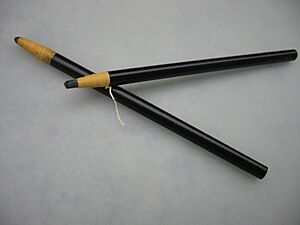Grease pencil facts for kids
A grease pencil is a special kind of writing tool. It's also called a wax pencil, china marker, or chinagraph pencil. It's made from hardened colored wax, similar to a crayon, but much stronger. Grease pencils are great for writing on smooth, shiny surfaces that regular pencils can't mark.
These pencils are usually made from safe, non-toxic waxes like paraffin or beeswax. The marks they make can handle moisture and are often easy to wipe off with a paper towel.
How Grease Pencils Are Made
Grease pencils come in a few different styles. Some look like regular pencils with a wooden casing. You sharpen these with a knife or a pencil sharpener.
Other types have a paper wrapping. To sharpen them, you just pull a string to peel off the paper. This means you don't need any extra tools! More recently, you can even find them in a "propelling" style, like a mechanical pencil. These are often used by pilots in the military.
What Can You Mark?
Grease pencils are super useful because they can write on many different surfaces. These include:
- Glass
- Rocks
- Shiny stone
- Plastic
- Ceramics
- Acetate (a type of clear plastic)
- Other shiny or polished surfaces
- Metal
They are also used on glossy paper, like for photographic printing or X-rays. People use them to mark maps or to make edits on audio tapes and film. In theaters, they help label lighting gels.
Builders and handymen often use grease pencils because they rarely scratch the surface they are marking. You can even use them on wet surfaces! Some artists also love using them. Long ago, they were used to mark glassware during production, especially porcelain, which is why they were sometimes called "chinagraph" pencils. They were also used in hospitals and science labs.
Where Grease Pencils Are Used
Grease pencils had a big role in the mid-20th century, especially in places like aircraft control centers and military radar stations. Technicians would use them to write information about planes, like their location and fuel, onto large clear glass panels. Officers on the other side of the panel could read this information, which was updated all the time. Today, computers and digital screens have mostly replaced this method.
In old radio studios, where they had many LP records, a grease pencil was used to mark tracks that were not allowed to be played on air. A wavy line would be drawn on the record, warning the presenter and making that track unusable.
Firefighters in the United Kingdom also use grease pencils. Officers who keep track of firefighters wearing breathing equipment use them to write important details, like where the firefighters are, on a control board.



